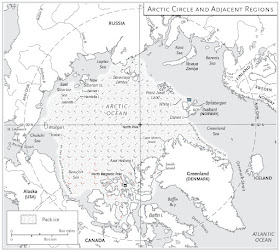

Dwindling Arctic Sea Ice
According to a new NASA study, Arctic perennial sea ice has been decreasing at a rate of 9 percent per decade since the 1970s. The changes in Arctic ice may be a harbinger of global climate change, says Josefino Comiso, researcher at Goddard Space Flight Center, in Greenbelt, Maryland. In a recent Journal of Climate paper, Comiso notes that most of the recent global warming occurred over the last decade, with the largest temperature increase occurring over North America. Researchers suspect the loss of Arctic sea ice may be caused by changing atmospheric pressure patterns over the Arctic that move sea ice around, and by warming Arctic temperatures that result from the buildup of greenhouse gases in the atmosphere.
The image above shows a comparison of composites over the Arctic Circle, acquired in 1979 (top) and 2003 (bottom) by the DMSP Special Sensor Microwave Imager (SSMI). The first image shows the minimum sea ice concentration for the year 1979, and the second image shows the minimum sea ice concentration in 2003.
#
People have been living within the Arctic Circle for several thousand years, but for much of that time they did not have any communication with peoples outside their region. In the ancient civilizations centered around the Mediterranean, peoples’ ideas about the North Pole region were completely speculative, often based on myths. Rumors of a cold region far to the north must have reached some of these ancients; mariners and merchants would have met men who had had some experience with the polar region.
Probably the oldest known account of contact with either polar region was that of the voyage by Pytheas, a Greek from Massalia (present-day Marseilles, in France), about 325 B.C. He referred to an island north of Britain— “Thule,”—and a frozen sea, but exactly what land Thule was or how far north it was could only be imagined, considering how little geography of the Earth was known. The ancient Greeks were nonetheless quite curious about the unknown north and gave it the name Arktos, “the bear,” the same name for the constellation that appears in the northern sky and that today is still known as the Great Bear. Some Greeks believed that people called the Hyperboreans (those beyond the north wind) were living in a paradise so far north that they escaped the harsh climate associated with the Arctic.
In the centuries that followed, little true knowledge of the Arctic region was gained. Maps of the later Greeks and Romans, for instance, continued to be based heavily on fantasy and speculation rather than exploration and knowledge. The Roman historian Tactitus (ca. A.D. 55–120) described people of the north who were probably those known today as Lapps, but few people would have known of such writings. In the 10th and 11th centuries, however, this changed for some Europeans when Norwegian Vikings moved westward, first to Iceland and then to Greenland.
About the year 1000, a few even briefly settled a land to the west that they named Vinland, now believed to have been the tip of Newfoundland. The Vikings brought tales of wild, hostile people back to Iceland and Norway. They told also of a climate warm and habitable to the south and impossibly cold to the north. All of this was set down in long accounts known as sagas, which record the explorations of the Norwegian Vikings in the 10th, 11th, and 12th centuries. Few people outside the Viking community, however, knew of these sagas.
In 1555, Olaus Magnus, the Catholic archbishop of Sweden, published a treatise called A History of the Northern Peoples, which drew in part on Viking accounts of travels in the New World—that is, Greenland and Vinland. This account was the basis of European knowledge about the Arctic for the next century. Meanwhile, by the end of the 16th century, exploration and an interest in geography and cartography had vastly improved Europeans’ sense of what the Earth looked like. In 1595, a comprehensive atlas of the world, the work of the great Belgian mapmaker Gerardus Mercator, contained a chart of the Arctic. The chart asserted that under the North Pole “lies a bare rock in the midst of the sea. Its circumference is almost 33 French miles, and it is all of magnetic stone.” Mercator also described a giant whirlpool at the Pole into which poured all the polar waters.
The reference to “magnetic stone” reflected the fact that by this time mariners knew that the magnetic needles of their compasses pointed to the North Magnetic Pole when in the Northern Hemisphere and to the South Magnetic Pole when in the Southern Hemisphere. Since about 1450, too, some were beginning to realize that the North Magnetic Pole was not exactly the same as the “true north”—the imaginary point at the opposite ends of the Earth where all the lines of longitude meet. The mixture of fact, near fact, and pure fiction exemplified by Mercator’s chart characterizes the state of knowledge about the North Polar Region circa 1600. Speculation and guesswork had not and could not provide accurate information about the geography of the Arctic. Exploration of the area by ship or overland would still be required to solve the mystery of what lay inside the Arctic Circle and at the North Pole.
The search for sea routes linking the Atlantic and Pacific Oceans across the top of North America (the Northwest Passage) and across the top of Eurasia (the Northeast Passage) as well as the journeys of whalers and sealers into unknown northern waters brought about the discovery and the exploration of the Arctic. By the mid-1800s, the Arctic Circle around the North Pole was complete, but what was inside was still largely a mystery.
No comments:
Post a Comment
Note: Only a member of this blog may post a comment.